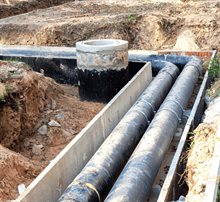Structure of heating tariffs
A heating tariff consists of two parts: the consumption-dependent part (euros per GigaJoule (GJ)) and the consumption-independent part (euros), also called the variable and the fixed part. The Dutch Heat Act stipulates that the Netherlands Authority for Consumers and Markets (ACM) must set maximum tariffs, so that a user does not pay more than when heating with natural gas. This is known as the NMDA (‘Niet Meer Dan Anders’, or ‘No More Than Otherwise’) principle. This link to the price of gas has caused maximum tariffs to rise sharply in recent years. Heating companies' tariffs were allowed to rise without transparency as to what these tariffs are based on.
Comparing heating tariffs
TNO used an integral tariff for comparing heating tariffs, which includes both the fixed and variable parts. This is calculated by dividing the annual bill by the annual heating consumption and is expressed in euros per GJ. For the international comparison, we used the average annual bills and consumption by consumers from different countries
Heating is more expensive in the Netherlands than in other countries
The average integral tariff in the Netherlands in 2023 was higher than the tariffs in Finland, Denmark, Sweden, and Germany. The integral tariffs of the Dutch supplier were two to three times higher than in the other countries. In the Netherlands, heating tariffs averaged 66 euros per GJ. Average tariffs were lowest in Sweden, at 23 euros per GJ, and highest – after the Netherlands – in Germany, at 38 euros per GJ.

Figure 1 Comparison of integral tariffs (fixed and variable) for the Netherlands, Denmark, Sweden, Finland, and Germany in 2023. The average tariff and spread are indicated. For the Netherlands, the tariffs both including and excluding the price cap are given. The methodology for calculating integral tariffs is described in a report for the Dutch Ministry of Economic Affairs and Climate Policy. The calculation used public data from heating companies, regulatory bodies, and consumer organisations. The sources are at the end of the article.
2023 exceptional due to price cap
Sharp rises in energy prices in response to the Ukraine crisis made 2023 an exceptional year. Governments in various countries therefore imposed a price cap. In this way, governments guaranteed consumers a maximum tariff. If a supplier charged a higher rate, the government made up the difference.
The ‘tariffs excluding price cap’ are the tariffs that the heating companies charged to the users. The figure shows tariffs for the Netherlands including and excluding the price cap. Excluding the price cap, the integral tariffs are 96 euros per GJ, which is 30 euros per GJ more than including the price cap. For Denmark, Sweden, and Finland, there was no price cap for collective heating. In Germany, the price cap was 26 euros per GJ.
Few financial incentives for a lower tariff
Furthermore, the difference in the spread in rates is striking. In the Netherlands, the spread between the heating tariffs of the largest providers including price cap is small. This is probably due to the maximum tariffs, which are set by the ACM. There are few financial incentives for energy suppliers to charge a lower tariff, even if they could on cost grounds.
In Denmark, heating tariffs are cost-based. Costs at some heating companies are higher than others, and this is reflected in the tariffs. For Germany, data were only available on the average rate and not on the spread.
The difference in tariffs has increased in recent years. What is striking is that tariffs in the Netherlands have increased more sharply from 2019 to 2023 than in the other countries. While in Sweden tariffs went up by 11% from 2019 to 2023, in the Netherlands they increased by 62% from 2020 to 2023. After the Netherlands, Finland had the largest increase, at 28% from 2019 to 2023.

Figure 2 Comparison of integral tariffs (fixed and variable) for the Netherlands, Denmark, Sweden, Finland, and Germany for the period 2019-2023. The average tariff and spread are indicated. For the Netherlands, the tariff including (2023) and excluding (2023*) the price cap are both given.
Differences are hard to explain
Tariffs depend on several factors. This makes it difficult to explain differences between them. In the Netherlands, there are maximum tariffs
that depend on the price of gas. Due to the increased gas price, the maximum tariffs, and therefore the tariffs paid by consumers, have risen along with it. Other countries do not have such a direct link to the gas price.
In Denmark, tariffs are based on the costs of heating. A heat network running on biomass therefore does not react to any increase in gas prices there. In the Netherlands, we have no insight into the costs of heating. As a result, it is not possible to say how the increase in tariffs is rationalised or substantiated.
Sources
Below you'll find the list of sources for this analysis, based on Dutch, German, Swedish, Danish, and Finnish sources
Eneco (2023) Algemeen tarievenblad voor Warmte & Koude. To be found: www.eneco.nl
Ennatuurlijk (2023) Ennatuurlijk tarieven 2023. To be found: www.ennatuurlijk.nl
Forsyningstilsynet (2023) Fjernvarmepriser. To be found: www.forsyningstilsynet.dk
Heizspiegel (2023) Heizspiegel für Deutschland. To be found: www.heizspiegel.de
Huygen, A., Verstraten, P. (2022) Vergelijking tarieven collectieve warmtesystemen in Nederland met tarieven in Zweden, Denemarken en Duitsland. To be found: https://www.rijksoverheid.nl/documenten/rapporten/2022/01/21/vergelijking-tarieven-collectieve-warmtesystemen-in-nederland-met-tarieven-in-zweden-denemarken-en-duitsland
HVC (2023) Warmtetarieven. To be found: www.hvc.nl
Nils Holgersson Rapporten (2023) Fjärrvärme. To be found: www.nilsholgersson.nu
Omakotiliitto (2023) Kaukolämpö hinnat ja muutos yhtiöittäin 2023. To be found: www.omakotiliitto.fi
SVP (2023) Tarieven en betalingen. To be found: www.svpparticulier.nl




